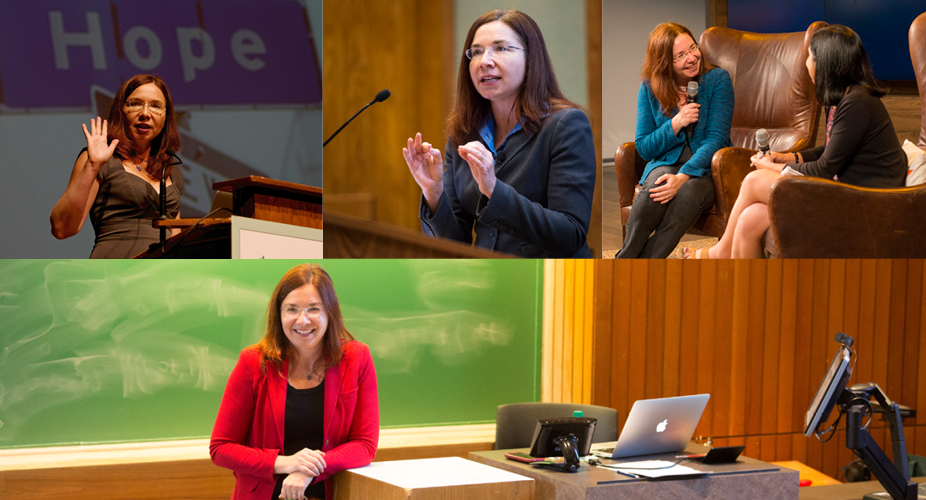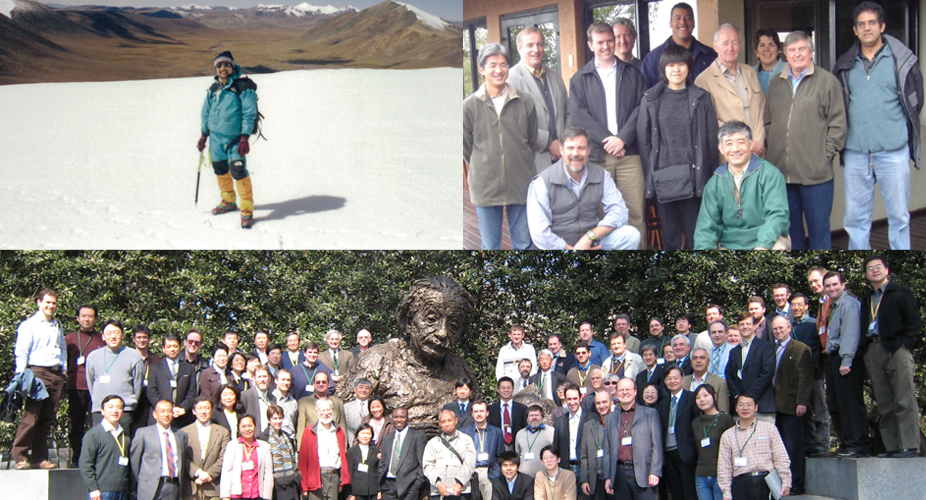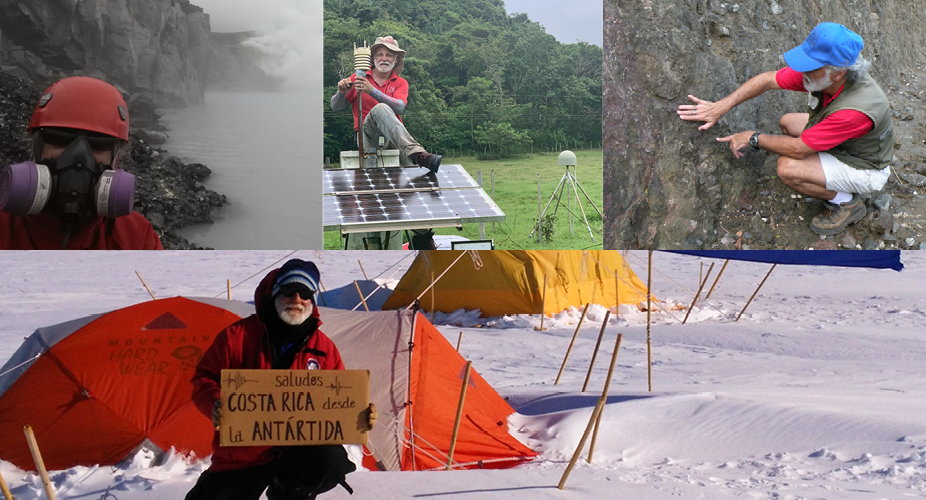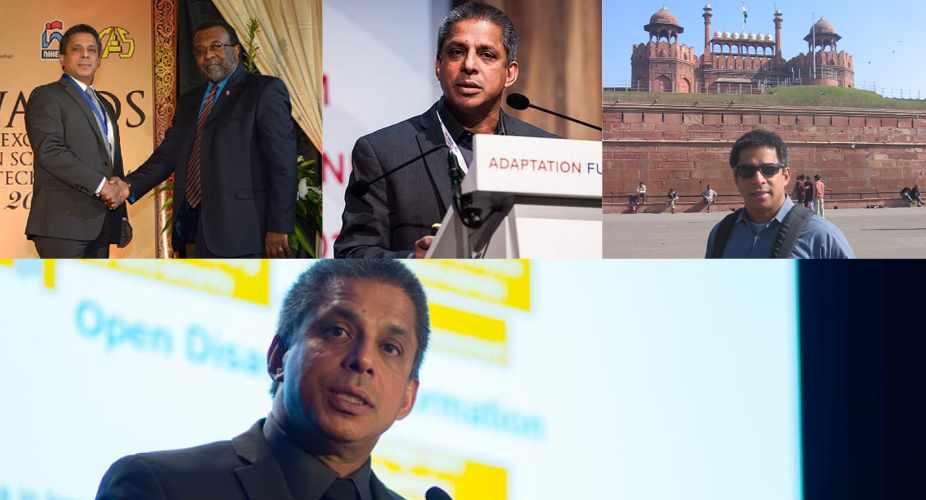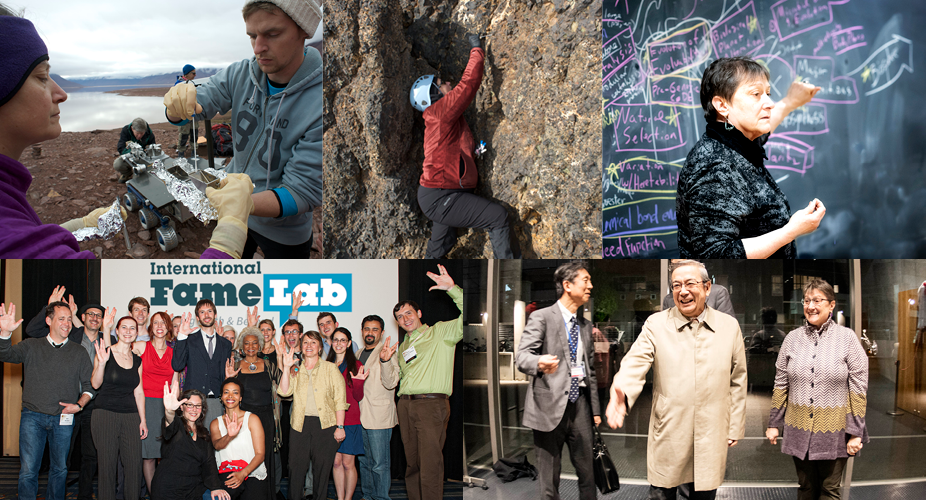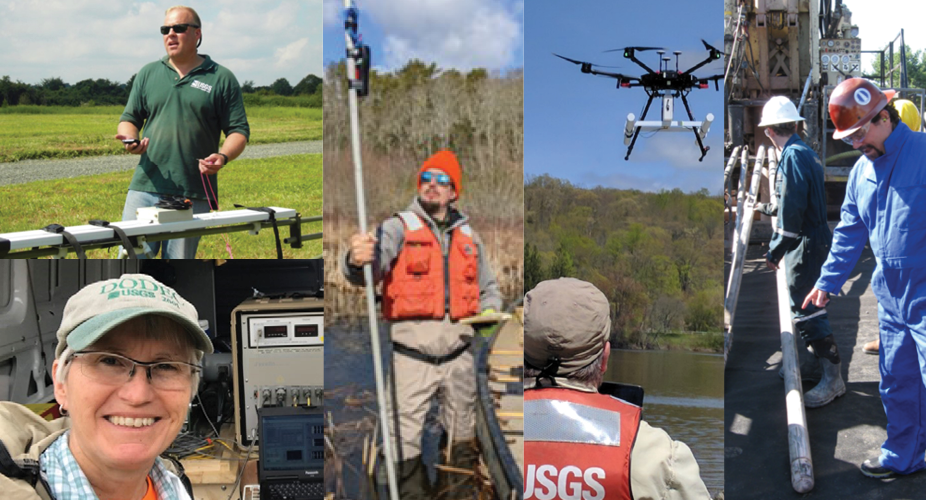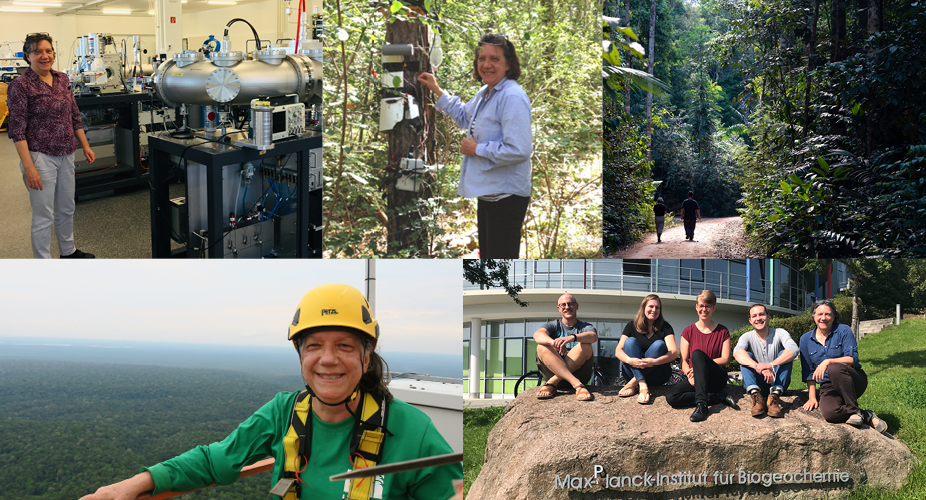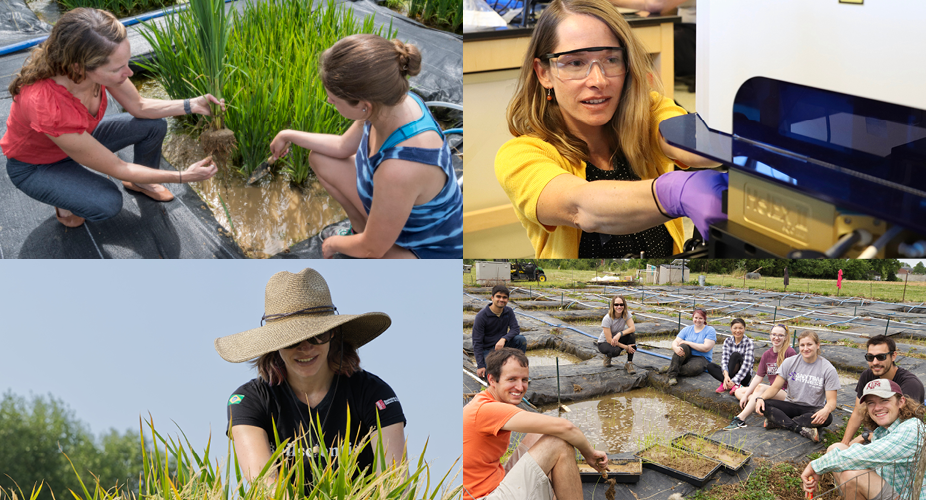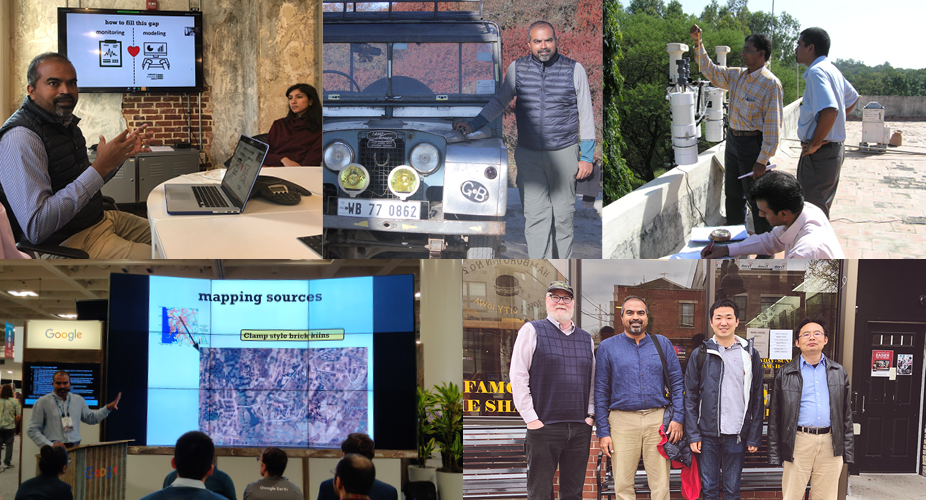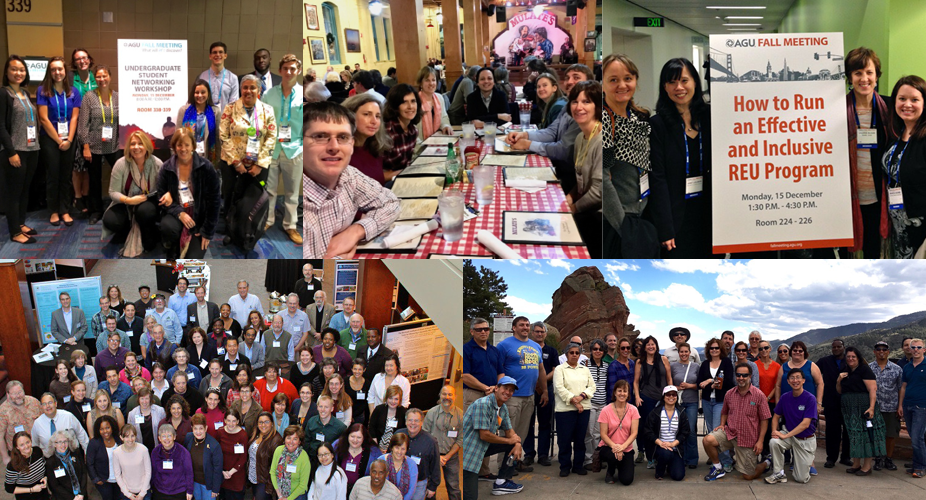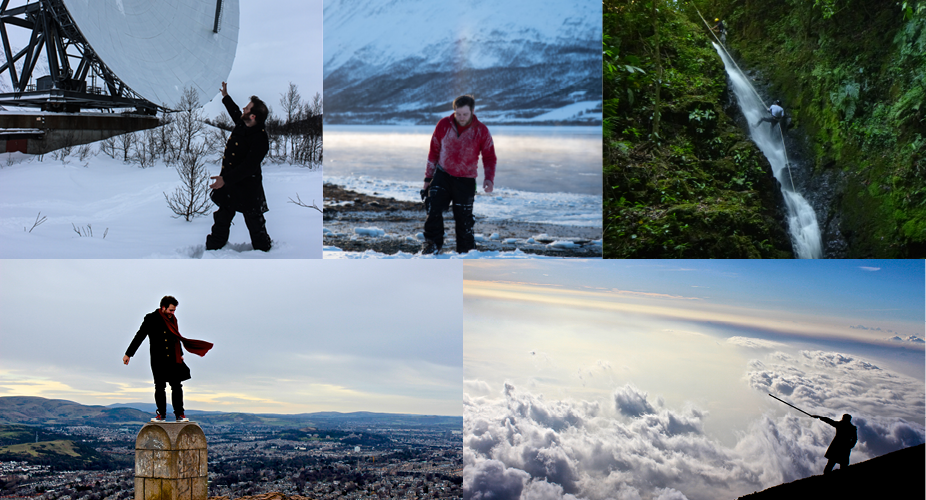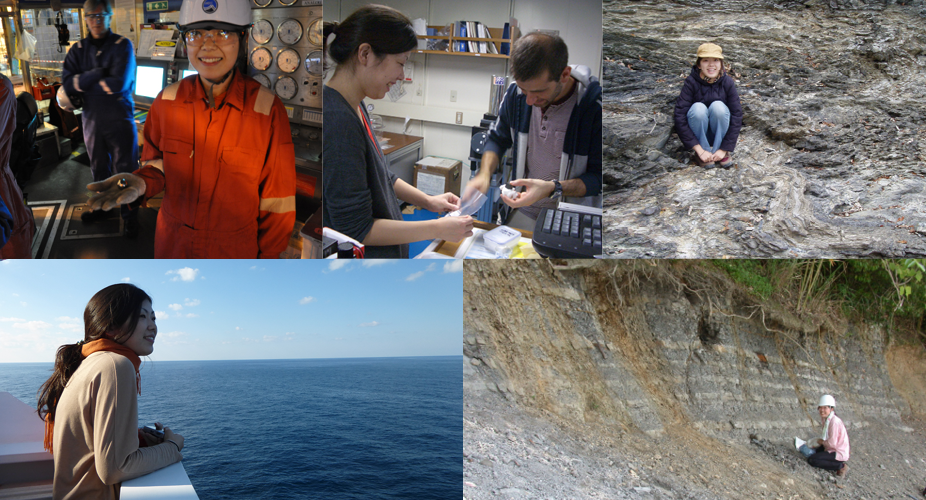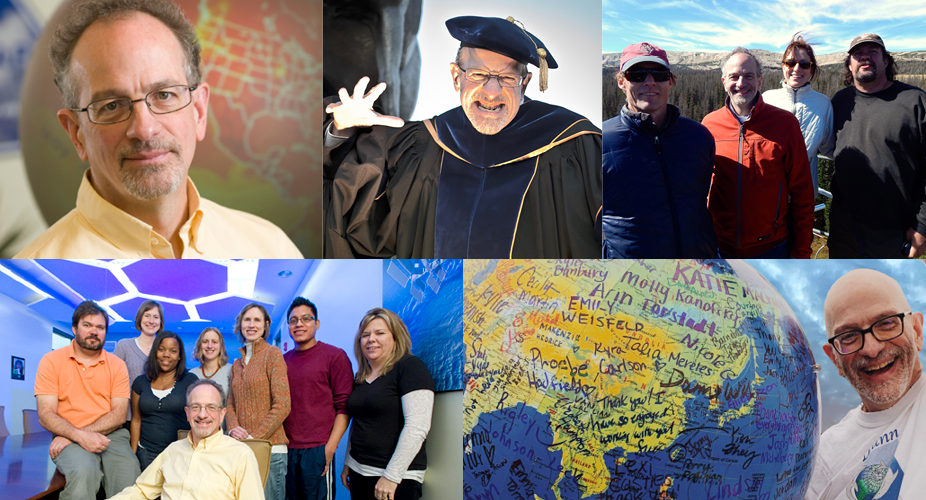Union Awards & Prizes
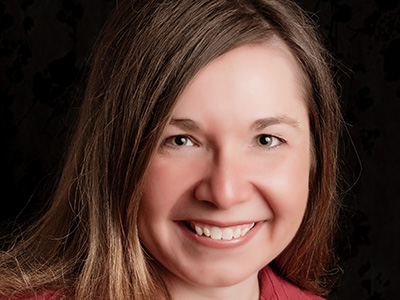
Citation
The Ambassador Award recognizes social impact and service to the scientific community. Professor Katharine Hayhoe epitomizes this award and is a guiding light for climate scientists seeking to hold productive conversations across cultural and political divides. Her tireless work over the years has led her to become one of the most important public voices on climate change and put her in the same league with the likes of Carl Sagan or Stephen Schneider.Katharine’s efforts in communications are legendary. She does hundreds of interviews every year, dozens of public lectures, and a PBS digital series on YouTube, and she is active on social media (collectively she has 400,000 followers). She also co-founded the organization Science Moms to help mothers who are concerned about their children’s planet but don’t know how they can help. We literally don’t understand how Katharine gets everything done.
In her research, Katharine has been active in helping both cities and the country assess the risks they face from climate change. Her research focus on downscaling emerged from her work on a regional Great Lakes assessment in 2003. She has since served as an author for the Second, Third and Fourth National Climate Assessments and took on a particularly prominent communication role for the Fourth National Climate Assessment, which was released during the Trump administration with minimal federal communications support.
Most recently, she published her book Saving Us: A Climate Scientist’s Case for Hope and Healing in a Divided World, which is a national bestseller. This book showcases Katharine’s most important quality, an eternal optimism and can-do spirit. Despite how discouraged we often are about climate change, after reading it we couldn’t help but be optimistic. She reminds us that the climate crisis is a solvable problem — if we make the effort.
While all of us strive to change the world, Katharine is actually doing it. This is why the Ambassador Award is such an appropriate recognition for her.
— Andrew Dessler
Texas A&M University
College Station, Texas
— Robert Kopp
Rutgers University
New Brunswick, New Jersey
Field Photos
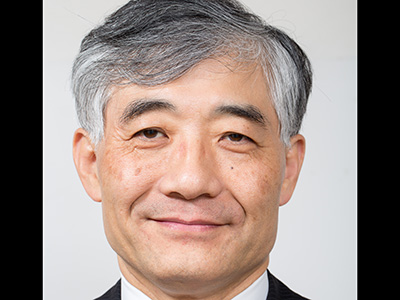
Citation
The scope of Dr. Koike’s activities has been broad, crosscutting several aspects of Earth sciences over his extensive career. The importance of his contributions is seen in the influence he has had on the community in planning large-scale environmental experiments and new paradigms for integrating data and models to create hydrologic knowledge for decision-making and benefitting society.Dr. Koike’s research over the years has covered a wide range of hydroclimatological areas, including hydrologic modeling, satellite-based data assimilation, and large-scale field and process studies, especially the extended studies related to the hydroclimatology of the Asian summer monsoon and water balance on the Tibetan Plateau. Toshio is best known for his development of an integrated hydrological modeling system with emphasis on the biospheric elements, including energy and carbon dioxide fluxes and soil moisture distribution.
Toshio’s scientific leadership has contributed significantly to research initiatives of the World Climate Research Programme’s (WCRP) Global Energy and Water Cycle Experiment (GEWEX). The initiation and implementation of the GEWEX-Asian Monsoon Experiment (GAME)-Tibet project is a great example of his leadership. The impact of GAME on the international scientific community is seen in the thousands of published scientific articles, referencing the use of data and knowledge from the GAME-Tibet program.
In addition to his scientific contributions, Dr. Koike has been a leader in shaping several international programs. He was a leader in embedding science into the Sendai Framework for Action on Disaster Risk Reduction. He has been a key player in the intergovernmental Group on Earth Observations (GEO), which initiated the Global Earth Observation System of Systems. For his part, he led the contributions of Japan for integration of observations and model simulations of international programs (WCRP/GEO/Global Climate Observing System) by facilitating the University of Tokyo to serve as a data hub archive with mirror sites around the world. He was instrumental in establishing Asia-Oceania Group on Earth Observations in cooperation with the governments of China, Korea and Australia. Dr. Koike serves as a role model when it comes to training a new generation of scientists. As the executive director of the International Centre for Water Hazard and Risk Management, he has created a training program for young scientists and practitioners from many developing countries including Bangladesh, Pakistan, the Philippines and others. Professor Koike’s outstanding contributions exemplify the spirit of the Ambassador Award and AGU’s goal of recognizing individuals committed to “advancing discovery in Earth and space sciences and its benefit for humanity and the environment.”
— Soroosh Sorooshian
University of California, Irvine
Irvine, California
Response
I am truly honored to receive the AGU Ambassador Award. I would like to thank my nominators, Professors Soroosh Sorooshian, Gordon McBean and Jeff Dozier, and my supporters, Drs. Antonio Busalacchi, Kevin Trenberth and Ghassem Asrar.
I have been working on integrating data and models, particularly satellite data assimilation, to create hydrologic knowledge for helping to make science-based decisions. As a professor at the Nagaoka University of Technology and the University of Tokyo and the executive director of the International Centre for Water Hazard and Risk Management (ICHARM), I have also been creating education and training programs for young scientists and practitioners from many developing countries. I am deeply grateful that these research and educational projects have given me many chances to bridge the gap between science and local actions and contribute to various policy- and decision-making processes.
Today, water-related disasters intensified by climate change are affecting various aspects of society all over the world. The impacts have extended to the water-food-energy nexus and the quality of life. When these circumstances worsen, society will eventually be plagued with problems arising in such areas as gender, equality and peace to a great degree. Throughout the COVID-19 pandemic, which has led to serious damage directly to our health, the world has learned that complex, cascading and systemic risks that are usually implicit in social, economic and environmental systems can suddenly emerge and threaten humanity beyond boundaries in space and time.
“How should humanity survive such risks and live with them in a sustainable way?” is a fundamental question.
The science community should support society’s transformation into a resilient, sustainable and inclusive body by playing key roles in cross-sectoral decision-making. The Chair’s Summary, approved at the 4th Asia-Pacific Water Summit held in Kumamoto, Japan, in April 2022, clearly states the following three targets:
- Promote water cycle consilience by accelerating the open science policy, particularly focusing on observation, modeling and data integration.
- Foster "facilitators," that is, catalytic beings who can lead the way toward resolving problems by providing professional advice on site using a broad range of scientific and Indigenous knowledge.
-
Work together beyond disciplines and sectors among different levels while taking an end-to-end approach.
I have been blessed with so many great opportunities to address these three targets in collaboration with excellent, enthusiastic leaders and colleagues and young scientists and practitioners all over the world. I am delighted to receive the 2022 Ambassador Award on behalf of all these people.
Thank you.
—Toshio Koike
International Centre for Water Hazard and Risk Management
Tsukuba, Japan
Field Photos

Citation
Marino Protti is a respected seismologist with a long list of well-cited journal articles on his CV. What makes Marino uniquely qualified for the Ambassador Award is his ability to spawn collaborations that advance earthquake forecasting and hazard mitigation.Over his career Marino initiated numerous international research projects. He had three goals: first, do good science; second, exploit the geography and geology of Costa Rica to study the subduction seismic cycle; and third, raise public awareness in Costa Rica and the world about seismic hazard. His view was that all three goals would be best advanced by collaborations involving seismologists, geodesists, geologists and other scientists from around the world, each bringing their expertise (and instruments and funding) to the table.
When Marino started his career in the 1980s, there was little appreciation of seismic hazard. Marino worked tirelessly to get the message out that earthquake and volcano hazard could be forecast, and preparations could be made. For seismic hazard, that meant strengthening building codes. Decades later, his efforts paid off when an M 7.6 earthquake struck the northwest coast of Costa Rica. While damages were extensive, casualties were limited.
Early in his career, Marino worked with Costa Rican colleagues to establish Observatorio Vulcanológico y Sismológico de Costa Rica (OVSICORI). This is a remarkable organization, charged with earthquake and volcano monitoring and hazard mitigation, affiliated with the Universidad Nacional (UNA). OVSICORI-UNA maintains a sophisticated network of real-time and near-real-time geophysical monitoring equipment throughout the country. They are a model for other Central American nations facing similar hazards with limited resources.
Marino worked with American scientists involved with the National Science Foundation’s MARGINS program, which ran from 2001 to 2010, to get the northwest coast of Costa Rica declared a special focus site for the study of subduction zone earthquakes (a similar program continued the following decade under GeoPrisms). Seismic and geodetic networks were established to augment OVSICORI’s monitoring efforts, beginning in 2001 and continuing today. When the 2012 earthquake struck, more than a decade of spatially and temporally dense seismic and geodetic data had been collected, capturing the late stage of a seismic cycle and making the earthquake an exceptionally well monitored event.
Marino is currently working with other Central and South American countries on issues related to marine conservation and Law of the Sea. He is promoting the idea of Costa Rica as a signatory to the Antarctic Treaty. The hope is that this country, one of the few in the world without a standing army, can be a voice for conservation, research and continuation of that continent’s nonmilitary status. In these troubling times, we need more such efforts.
— Timothy Dixon
University of South Florida
Tampa, Florida
Response
It is with great humility that I receive this award while thanking both the colleagues who nominated me as well as the judges who chose me.
More than as an individual merit, I want to acknowledge that what I have done in almost four decades is thanks to a chain of institutions and people. The Costa Rica Volcanological and Seismological Observatory (OVSICORI) is a great institution that has given me all the conditions to grow scientifically without bounds. OVSICORI can do that because behind it is the National University of Costa Rica with a strong commitment for public service. My colleagues from the United States, Japan and Europe have provided me with instrumentation and opportunities to contribute to the understanding of subduction process in Costa Rica, share it with the world, and trickle it down to the population of Costa Rica. As a result, I believe that Costa Rica is the country with the highest tectonically educated people in the world. As an example, thanks to the dissemination of the knowledge we are producing, most Costa Ricans can explain in simple words what subduction is.
By abolishing the army and therefore not wasting money on defense, Costa Rica has been able to invest large amounts of resources in education and health care for all its citizens. I have been a direct beneficiary of these circumstances, and having come from a low-income family with half a dozen siblings (all of them with higher education degrees in science and engineering), my only merit has been to work hard to pay back my country for the investment it put into me.
The only thing I claim is the ability to take advantage of every opportunity my colleagues and life put in front of me. Some have taken me down to 4,000 m below the sea surface, and others down to Antarctica on two occasions. I tell students to also take every opportunity because each one will open more doors to grow in science and life. Going to Antarctica exposed me to the Antarctic Treaty, and since I saw its beauty, I pushed Costa Rica into becoming the 55th party of such a novel international treaty for peace, science and conservation, features for which Costa Rica is also known around the world.
I only hope that this award will help me continue promoting Costa Rica as an excellent field laboratory to study subduction processes.
— Marino Protti
Observatorio Vulcanológico y Sismológico de Costa Rica, Universidad Nacional
Heredia. Costa Rica
Field Photos
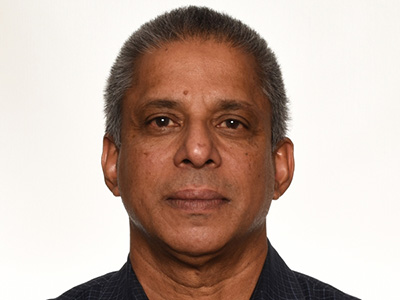
Citation
Roger Pulwarty is receiving the 2022 AGU Ambassador Award for his exceptional scientific, societal and policy impacts on disaster response, preparedness and risk reduction around the world.Roger has been a major player in some of the most significant policies and action plans the U.S. government has implemented in the areas of disaster science, response and preparedness. He was the founding director of the National Integrated Drought Information System (NIDIS) that transformed drought management in the United States.
Roger’s international contributions are all also well-known and recognized. He served as a convening lead author on U.N. Office for Disaster Reduction Global Assessment Reports, on the Intergovernmental Panel on Climate Change Working Group II, including Special Reports on Water Resources and on Extremes, and on the U.S. National Climate Assessment. He has provided testimonies before the U.S. Congress, served on National Academy of Sciences committees, and acts as an adviser on climate risk assessment and management to the Western Governors' Association, the Organization of American States, the U.N. Development Programme, the U.N. Environment Programme and the Interamerican and World Banks. He co-chairs the World Meteorological Organization Climate Services Information System Implementation Team and is the International Union of Geodesy and Geophysics scientific representative on the U.N. Global Framework on Climate Services.
Roger’s publications primarily focus on climate and risk management in the United States, Latin America and the Caribbean. In addition to research, he has created environments and programs for fostering interdisciplinary research. Roger has played a major role in leading innovative research teams and interdisciplinary program design and implementation to address complex environmental problems related to weather and natural hazards. He helped conceptualize, develop and then lead what he later named the NOAA Regional Integrated Sciences and Assessments (RISA) Program. These are applied research and decision support efforts now spread around 11 regions of the United States and recognized as prototypes for integrating physical and social sciences research into decision-making.
For his significant contributions, Roger has received many honors and awards. He is a co-recipient of the Department of Commerce Gold and Silver Medals for integrating scientific research into decision-making and the 2016 AGU Gilbert F. White Distinguished Award and Lecture.
Roger has a remarkable record of selfless public service; the promotion of geophysical sciences and scientific integrity in political arenas; and a tireless dedication to diversity, outreach, raising awareness and public engagement. We are thrilled that he has been selected as one of the recipients of the 2022 AGU Ambassador Award. Congratulations, Roger!
- Amir AghaKouchak,
University of California, Irvine
Irvine, California
response
I am deeply honored to receive an Ambassador Award from the American Geophysical Union. AGU epitomizes the professional organization that is dedicated to promoting the highest-quality science, ensuring that science contributes to solving societal problems, and fostering a cadre of innovative professionals dedicated to advancing knowledge and practices that support both of those goals. No recognition of this kind is the result of one person’s work.
I am thankful that AGU recognizes the contributions of multiple disciplines in enabling a resilient future, and as such, I sit on the shoulders of many and diverse giants. To paraphrase a question asked by the late geographer Gilbert White, “If we know so much, why aren’t we doing better?” AGU through the Ambassador Award acknowledges that the contributions of science in guiding us toward a more just and sustainable world is increasingly reliant on the joint construction of knowledge with diverse communities, an inherently social and behavioral process, aimed at enriching the human condition and sustaining livelihoods, ecosystems and well-being. With these thoughts in mind, my own attempts have been guided by two use-inspired questions: How best can we anticipate, develop and incorporate existing and new knowledge into better decisions, and as critically, how do we make sense of the multiple perceptions, values and frames to chart an equitable path forward? Interdisciplinary research and programs that systematize and communicate a body of knowledge for action are both necessary. The support of my colleagues and their intellectual contributions in understanding the beautiful complexity of the Earth system and the themes embodied in this award are humbling. They stand as pillars of outstanding competence, rigorously integrated knowledge, and, most importantly, as stellar human beings. I am fortunate to be able to rely on their minds and on their help.
We are accorded an honored role in society. To sustain that trust in a rapidly changing world, we need to not only live up to expectations of knowledge creation but to help imagine and create more equitable and sustainable futures. I am indebted to the AGU Honors team and committee. I thank Professor AghaKouchak and my colleagues who selflessly supported this nomination, the numerous mentors I have been fortunate to have had over many decades, my family, and my spouse, Susan Iott, who are the touchstones of quality and integrity for anything to which I am able, even minimally, to contribute.
- Roger S. Pulwarty
National Oceanic and Atmospheric Administration
Boulder, Colorado
Field Photos
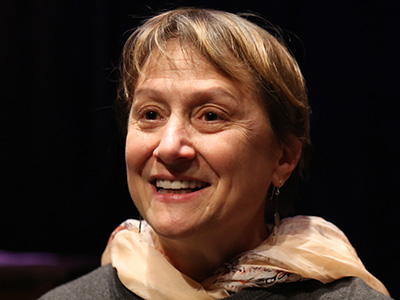
Citation
Mary Voytek is a transformative leader in the biogeosciences community. Her contributions over a 40-year career that is still unfolding exemplify the AGU values embodied by the Ambassador Award. Beginning in the 1990s, during an era in which most geoscientists saw “biogeosciences” as an oxymoron, she was a key leader in the movement that brought environmental microbiology and astrobiology into AGU, eventually helping to found and lead the Biogeosciences section.Later, at NASA, Mary reshaped the Astrobiology Program to empower an emerging generation of scientists who viewed astrobiology as their primary focus and mission relevance as a priority. Going far beyond normal program manager duties and taking serious professional risk, she was a key figure driving a wholesale reorganization of NASA’s planetary sciences programs to infuse them with astrobiology objectives. More recently, Mary shifted astrobiology community leadership from a centralized institute to a distributed “research coordination network” that she is nurturing toward maturity and has advocated for community definitions, community standards and consensus building around the standards of evidence needed to guide public and scientific discourse about the search for life on other worlds. Along the way, Mary worked extensively and systematically to elevate new talent into positions of responsibility, such as by recruiting and mentoring future scientist-administrators in astrobiology through the NASA Management Postdoctoral Fellow program.
Most recently, she advanced the global astrobiology community through her leadership of the Earth-Life Science Institute (ELSI) at Tokyo Tech. Mary has made it a priority to develop the international astrobiology community by fostering an integrative, collaborative and internationalist culture that makes ELSI a welcoming home for students and visiting scholars from around the world. If the day comes when there is credible evidence of life elsewhere, Mary’s leadership will have led us toward understanding, debating and interpreting that evidence as a unified global science community.
— Ariel D. Anbar
Arizona State University
Tempe, Arizona
Field Photos
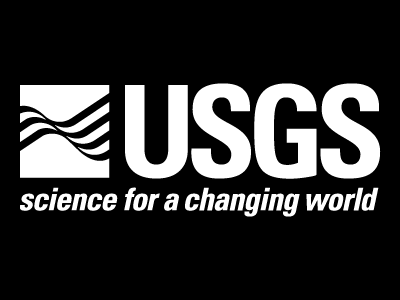
Citation
Two decades before the advent of hydrogeophysics sessions and the Near-Surface Geophysics section at AGU, the (now former) U.S. Geological Survey Hydrogeophysics Branch (HGB) was instrumental in demonstrating the significance of geophysical methods in hydrologic investigation from surface, subsurface and airborne platforms. Over the last ~30 years, the group has pioneered demonstrations of many new technologies and demonstrated the application of geophysical information in improving the understanding of geologic controls on groundwater flow, groundwater resource mapping and management, contaminant transport, remediation technologies, and exchanges between groundwater and surface water, among other areas of fundamental importance.Of arguably greater significance, however, was their tireless dedication to training and outreach to introduce geophysics into hydrogeologic investigations. These scientists were tireless in developing in-person and online training courses that explored data acquisition as well as data interpretation and the underlying principles used in data interpretation. Additionally, their geophysical equipment pool, open to the community, constituted important infrastructure for the hydrogeophysics. Borrowing geophysical equipment from them came with instruction and technical support in data acquisition and interpretation. This work was done selflessly, with senior scientists serving in support roles often without direct involvement in authorship on scientific products. These scientists also developed publicly available software tools that more easily facilitated data interpretation (e.g., for vertical temperature profiles, fiber-optic distributed temperature sensing data and flowmeter logs) and have developed decision support software to assist users in identifying the most appropriate geophysical tools to be applied for given hydrogeologic conditions. Benefits of their training and outreach have extended internationally.
These scientists sacrificed personal productivity to change the paradigm by which water resources investigations were conducted. They were responsible for making geophysical investigations an integral component in water resources investigations — within the USGS and other federal agencies, academic and research institutions, and the private sector, including engineering companies and geophysical equipment vendors.
Under USGS reorganization, the branch ceased to exist in 2022, but its impact over the past almost three decades of its existence perfectly exemplifies the criteria for the Flinn Award. Specifically, I would like to commend John W. Lane, Carole Johnson, John Williams, Cian Dawson, and Marty Briggs for the remarkable outreach activities of the USGS HGB over the past decades. This group has long played an outsized role in the hydrogeophysics community, and it is no exaggeration to say that the field as we know it might have looked really different without their selfless leadership.
— Kamini Singha
Colorado School of Mines
Golden, Colorado
Field Photos
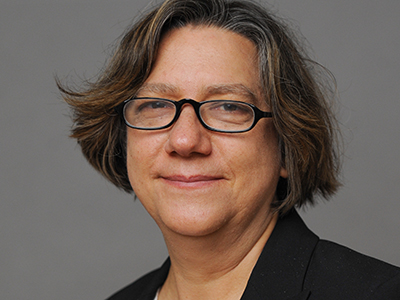
Citation
Sue Trumbore embodies the characteristics of the Kaula award, i.e., the “unselfish service to the scientific community through extraordinary dedication to, and exceptional efforts on behalf of AGU’s publications program” extraordinarily well, serving as a true role model for the community. She has served for 4 years as the chief editor for Global Biogeochemical Cycles (GBC) and then in 2019 became the founding editor in chief of AGU’s flagship journal AGU Advances. Sue has advanced these journals immensely during her tenure.First, she pulled GBC out of a doldrum, reorganized its editorial handling through a reorganization and expansion of the editorial board, and through these measures made it again the journal of choice for anybody interested in biogeochemistry. Second, she brought AGU Advances to life, set the vision, built a strong and diverse team of editors, and has been the driving engine of the journal ever since. Convincing authors to submit high-impact papers to a new and relatively unknown journal rather than existing prestige journals was a herculean task. Yet Sue rose to that challenge, attracting top articles to AGU Advances without negatively impacting submissions to other AGU journals. In fact, she very effectively used AGU’s journal network and worked closely together with AGU’s other editors in order to channel papers that were submitted to AGU Advances and deemed to be of high quality but not a good fit onward to the other journals. Thus, there is no doubt that the establishment and success of AGU Advances are due to Sue’s guidance, vision, and day-to-day engagement.
On top of this, Sue has been a powerful advocate of diversity, building a diverse group of editors and mentoring and nurturing them with great dedication. Many of the associate editors that Sue recruited throughout her years at GBC and AGU Advances continue to serve as editors for the different AGU journals, creating a long-living legacy of Sue’s dedication to the community. This commitment to the journals while building and caring for a diverse team of editors makes Sue an utmost deserving candidate for this year’s William Kaula Award.
— Nicolas Gruber,
ETH Zurich
Zurich, Switzerland
Response
I am honored to be recognized with the William Kaula Award, especially when there are so many dedicated and deserving people working hard to ensure the very high standards for science published in AGU journals. Many thanks to my nominators, Nikki Gruber, Eileen Hoffman, Katsumi Matsumoto, Mary-Elena Carr and Sara Mickaloff Fletcher.
While I have had the privilege to serve as editor-in-chief of two great AGU journals, I want to use this space to say a few words about AGU Advances. The idea behind Advances is to give Earth and space scientists an open access journal within our community to publish research and commentary that is of broad and immediate impact. I agreed to take on the job of founding editor-in-chief partly because I was tired of seeing so many AGU authors send their highest-profile work to journals outside of our community.
At Advances, we distinguish ourselves from other highly selective journals by allowing space for authors to explain the context of their findings and describe important details of methodology. Editors highlight how each paper we publish advances our science, and we often solicit viewpoints to help put the research in broader context. We make the review process transparent by publishing the paper’s history along with the accepted version. I am particularly proud of pieces we have published on how we do our science, including commentaries on how the increasing demands to wrangle big data are affecting students, and the ongoing editorial series highlighting issues around diversity, inclusivity and ethics in the geosciences.
For the success of the journal to date, I thank the Advances editorial board and Margaret Moerchen at AGU for shaping our journal. We have benefitted from the cooperative spirit of AGU’s journal editors and the support from AGU Publications staff and the Wiley team, most of whom spent the last years working from home. Finally, thanks to the authors who took the risk to submit their papers to a journal that at the time had no impact factor.
While the peer review system is not perfect, it is still the best tool we have to ensure the quality and trustworthiness of the science we publish. I am glad that the William Kaula Award exists to recognize the important contributions of those who support AGU publications and honored to be this year's recipient.
— Susan Trumbore
Max Planck Institute for Biogeochemistry
Jena, Germany
University of California, Irvine
Irvine, California
Field Photos
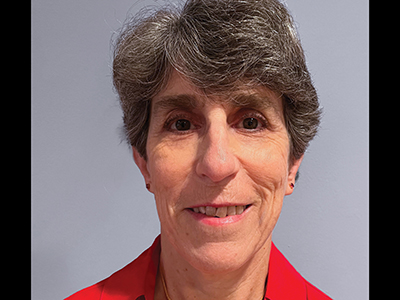
Citation
For nearly 40 years, Dr. Ellen Kappel has provided extraordinary and unselfish service to the international geoscience community. In an endeavor where cooperation is essential, no one else has better combined deep scientific knowledge with considerable talent for strategic planning, communication, enhancing career development and diversity, and successfully bringing people together.Through her work on hundreds of reports, science plans, brochures and other materials, it is widely thought that Ellen has helped secure more funding from government sponsors for the international ocean and Earth science communities than perhaps any other individual.
After completing a Ph.D. at Columbia University’s Lamont-Doherty Earth Observatory in marine geology and geophysics and working there as a postdoctoral research scientist, she moved to Washington, D.C. For the next dozen years, she held successively higher positions at Joint Oceanographic Institutions Inc., managing the operations of the international Ocean Drilling Program and the associated U.S. Science Support Program supported by the National Science Foundation. She was widely praised by her colleagues for her program management skills, her understanding and appreciation of science, and her efforts to advance cooperation, communication and outreach.
In 1999, she founded Geosciences Professional Services Inc. (Geo Prose), which promotes the geosciences through writing, editing, document and web design, and project management.
Geo Prose projects have included decadal and strategic plans for major geoscience programs such as EarthScope, IRIS (Incorporated Research Institutions for Seismology) seismological facilities, scientific ocean drilling, U.S. Geological Survey Coastal and Marine Hazards and Resources, German National Academy of Sciences Leopoldina, and Ocean Networks Canada. They have also included reports for U.S. agencies and academic nonprofit consortia on subjects including federal oceanographic fleet status, national ocean research priorities, autonomous oceanographic instrumentation, high-performance computing, mineral physics, research in tectonics, Earth science literacy principles, broadening participation in the geoscience workforce, Antarctic logistics, and Arctic research.
Since 2004, Ellen has also served as director of publications and editor of Oceanography. Noteworthy issues include two volumes of “Women in Oceanography” that have inspired a new generation of women oceanographers.
Dr. Kappel is one of the most effective and impactful leaders in our profession. Her unique role within our community defies description by a familiar “label.” And as a female scientist, in what has been a historically male-dominated field, she should be celebrated as a pioneer and a role model, as we all work toward greater diversity and inclusivity.
— John Farrell
U.S. Arctic Research Commission
Arlington, Virginia
response
My career in the geosciences began and flourished because countless people opened doors. While I was an undergraduate at Cornell, generous professors went the extra mile to provide field and research experiences, from the American West to the Swiss Alps, and encouraged me to attend graduate school. While I pursued my Ph.D. at Columbia’s Lamont-Doherty Earth Observatory, mentors sent me out to sea again and again to learn how to collect data and lead a team, all at a time when women on research vessels faced daunting obstacles. The wonderful scientists who furnished those opportunities continuously challenged me while never once setting me up for failure. They taught me what it means to be a good mentor.
After graduate school, I took a job at Joint Oceanographic Institutions (JOI), helping to manage the Ocean Drilling Program. I benefited greatly from generous colleagues at JOI and the National Science Foundation who showed me what effective program managers can accomplish. During nearly 12 years at JOI, I also learned a tremendous amount from the scientists, engineers and professional staff who dedicated themselves to this remarkable program. Through my work at JOI, I learned that advocating for the community could be as fulfilling a career as doing research. The connections I made and the management skills I gained at JOI would serve me well when, quite accidentally, I became an entrepreneur and set up Geo Prose. Importantly, during my time at JOI desktop publishing emerged as a tool for in-house production of brochures and newsletters. Thanks to this new software, I began a long partnership with a talented graphic designer who has been critical to Geo Prose’s success.
It's now more than 20 years since I established my company. I am grateful to the many scientists and managers who have trusted me to help shape and polish their science plans. I am grateful for the chance to contribute to documents involving such a wide variety of science and to learn continuously through my work. I am grateful for the friendships I have made through the projects and publications I’ve touched. But most of all, I am grateful to all the people, over so many years, who have opened the doors I’ve walked through.
— Ellen Kappel
Geosciences Professional Services Inc.
Bethesda, Maryland
Field Photos
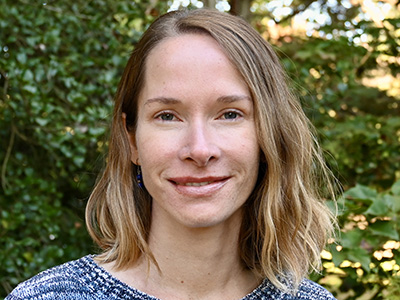
Citation
Dr. Angelia Seyfferth’s research brings geochemical insight to societally critical problems, mostly focusing on healthy and sustainable rice production systems and salt marsh biogeochemistry and carbon cycling. Her research focuses on how small-scale soil-chemical processes influence contaminant (e.g., arsenic, cadmium, lead) and nutrient (e.g., silicon, phosphorus, iron, sulfur) release or attenuation, which has large-scale impacts on human and environmental health. A variety of cutting-edge approaches are utilized, including the coupling of laboratory experiments (for mechanistic information) and field-based observations to decipher contaminant and nutrient cycling and plant interactions under environmentally relevant conditions. Her work takes a systemic view of both research areas, investigating many potential pitfalls and trade-offs of different solutions. Specifically, her research on rice helped detect and elucidate the challenges of grain metal(loid) uptake — unfortunately, the anaerobic, flooded conditions of rice production allow the migration of arsenic into the grain, where it poses a human health risk. She uses big data to solve big problems in societally relevant metal cycling through the use of state-of the-art synchrotron analysis and data visualization of what is actually happening in the plant-soil interface with regard to contaminant uptake. The collection of rhizosphere chemistry images as well as grain arsenic images using synchrotron techniques has produced chemical "photographs" that can be used to better "see" what is happening.
Dr. Seyfferth’s work not only details the arsenic species present in rice plants and their distribution therein; it also takes a solution-oriented approach by investigating beneficial roles of silicon and irrigation water management in reducing the arsenic concentrations. Given the importance of rice as a food crop, particularly in developing nations and poor communities, the risks are great. Ultimately, she conducts basic research that can be applied to benefit society on a local-to-global scale.
Dr. Seyfferth has an unmatched ability to communicate the research she is so passionate about through her natural affability. She can effortlessly teach to a room full of students, receiving university-wide teaching recognition in the process; she can understandably explain the importance of contamination and responsible farming practices to a layperson; she can motivate and lead groups of natural and social scientists through interdisciplinary projects; she captures the attention of funding programs and government leaders as attested by her hugely successful grant and publication records. On top of her impressive research and academic rigor, she makes time to devote to outreach programs within the community that have made considerable impacts on environmental awareness.
— Brandi Kiel Reese
Dauphin Island Sea Lab and University of South Alabama
Mobile, Alabama
response
I am deeply honored to be named the 2022 recipient of the Charles S. Falkenberg Award. Charles Falkenberg’s legacy of data visualization for societal good has touched many people and will continue to live on. I am incredibly proud to be among the prestigious list of previous awardees.
My inspiration for using and communicating scientific knowledge to help people and the planet came from my grandparents, Len and Grace Bryant, and my late brother, Donny Seyfferth. From a very young age, my grandparents were instrumental in developing my passion for environmental science. My brother Donny was always smiling and received joy by doing good in the world and making others smile. I dedicate this award to them, for I wouldn’t be who I am as a scientist or a person without their influence.
I am sincerely grateful to the colleagues who supported my nomination and especially to Brandi Kiel Reese for nominating me. Thank you, Brandi! You have always been a supportive cheerleader and true friend in my corner.
To the many incredible students, collaborators and mentors I have had the privilege and pleasure of working with over the years, thank you! I wouldn’t be here without you. Thank you to my incredible research group (both past and present), you rock! Thank you to my undergraduate research adviser, Ryan Casey, and my analytical chemistry professor, Joe Topping, who gave me confidence that this girl who transferred from a community college could (should?) go to graduate school. Thank you to Dave Parker, my Ph.D. adviser, who took a chance on me and taught me a field of plant-contaminant interactions that was different from phytoremediation. Thank you to Scott Fendorf, my postdoc adviser, who let me “play” at the synchrotron to visualize metal(loid)s in plants and who continues to be a steadfast mentor and friend.
I am thankful to Brandi, my mentors, my research group, collaborators and friends who have supported me throughout my career. I am grateful for the love and unwavering support of my family. I thank the selection committee for honoring me with the Charles S. Falkenberg Award.
— Angelia Seyfferth
University of Delaware
Newark, Delaware
Field Photos
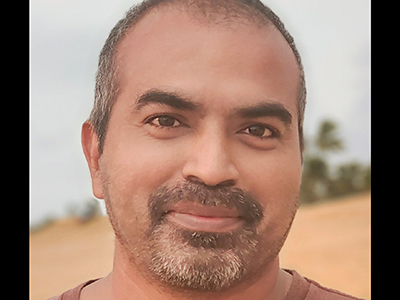
Citation
Dr. Sarath Guttikunda is a rigorous scientist and air quality modeler with a deep interest in community and policy action. He has a strong record of peer-reviewed publications in high-quality journals as well as reports, working papers and op-eds dissecting information for both scientific and public awareness.His focused efforts at science communication and outreach have been critical for the tools and knowledge being extensively used by scientists, regulatory agencies and policymakers in India and other countries in the Global South. His work has expanded the horizons of what we know about air pollution levels and sources, especially in India. At the same time, he continues to think about creative strategies for communicating science and effecting policy change. His work has been profiled in leading publications in India (The Wire, Times of India) and globally (The New York Times, New Yorker, etc.).
Over the last 20 years, he has developed analytical tools for integrated assessment of air pollution that have been applied in over 30 countries in Asia (Bahrain, Bangladesh, Cambodia, China, India, Indonesia, Japan, Kuwait, Kyrgyzstan, Mongolia, Nepal, Philippines, Qatar, Saudi Arabia, South Korea, Sri Lanka, Thailand and Vietnam), Africa (Ethiopia, Ghana, Kenya, Nigeria, Tanzania, Uganda and Zambia), eastern Europe (Bosnia and Herzegovina, North Macedonia, Serbia and Ukraine), and Latin America (Argentina and Mexico). His body of work has been influential for both the development of science and tangible policy changes that affect the lives of hundreds of millions of people around the world.
In 2007, Sarath set up UrbanEmissions, an entity that supports the development of a repository and a website for the public dissemination of information on air pollution. His work on preparing and updating emissions inventories for more than 50 Indian cities has enabled open access to air quality data and analytical tools and the launch of India’s only air quality forecasting system delivering information for all districts. He started the Air Pollution knowledge Assessments (APnA) program in 2016 that has resulted in long-term outlooks for emissions and pollutant concentrations and pollution control analyses for cities and sectors. His work on the health impacts of coal-fired power plants in India led to subsequent changes in the emissions regulations.
— Krishna AchutaRao
Indian Institute of Technology Delhi
New Delhi, India
Response
Thank you, Krishna, for the generous citation. I have always regarded the fellowship of AGU in high esteem, and having my contribution recognized by this body of peers for the 2022 International Award is an immense source of pride.
My research work focused on one simple idea — provide as much information as possible to people working on the ground, in the easiest format possible. How do we draw on publicly available information and consolidate it to decipher the state of air quality in a region? This demand for a better understanding is not limited to India, and we have a long way to go in addressing this for the cities in Africa, Asia, eastern Europe and Latin America — regions marked with the highest proportion of premature deaths linked to air pollution.
Traditionally, this starts with monitoring, field experiments and surveys, but my experience in the low- and middle-income countries is that there is still a shortfall in the availability of open information and experience to collect data. Given this vacuum, we are charting new ways to weave a story on air pollution while keeping science at its core and making the information accessible.
This body of work is not possible without the invisible bureaucrats who want to do the right thing, who are there in every city. They ask the right questions, provide crucial information, try to do what they can to move things forward, and help us find ways to address the knowledge gaps.
There are a lot of people who helped and mentored me along this journey. At Iowa, Gregory Carmichael continues to provide guidance and support even after 25 years, and Jeremie Moen has been patient with my constant queries on computational systems. A grateful thanks to my collaborators Krishna AchutaRao, Late Dinesh Mohan, Ambuj Sagar, Geetam Tiwari and Alan Gertler and to my co-conspirators Shahzad Gani, Rahul Goel, Christa Hasenkopf and Pallavi Pant, who never refused to join hands. A heartfelt bow to Giuseppe Calori, Maureen Cropper, Todd Johnson, Hiram Levy II, Vikas Mehta, Jitendra Shah and Youhua Tang, who helped me read, write and understand the world of atmospheric science at various times of my career. Thank you, and looking forward to continuing this journey together.
Finally, a special thanks to my wife, Puja, and my family, who wholeheartedly entertain my ravings and rantings on air pollution.
— Sarath Guttikunda
Urban Emissions
New Delhi, India
Field Photos
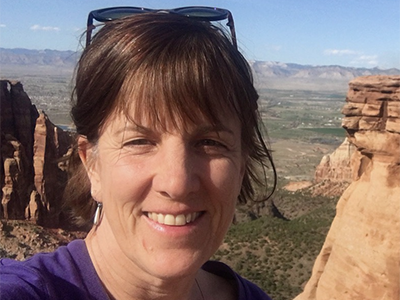
Citation
Valerie Sloan is recognized for her sustained, quiet and encouraging leadership of the National Science Foundation (NSF) Geosciences Research Experiences for Undergraduates (REU) community and for her impact in shifting REU programs to be more effective, diverse, safe and inclusive.Conversations among REU site managers at the first GEO REU PI Workshop in 2011 organized by Dr. Sloan quickly showed that sharing strategies was valuable. Val facilitated further discussions through a listserv, principal investigator (PI) workshops and conference sessions and so fostered cross-program collaboration and mentoring. Val also strengthened connections between REU managers and scientific societies like SACNAS (Society for Advancement of Chicanos/Hispanics and Native Americans in Science) and the NABG (National Association of Black Geoscientists). This was the founding of a nationwide GEO REU PI Network in which managers now share resources, tools and support on student selection, mentoring, professional development and cohort development. Prior to this, individual managers had to reinvent the wheel. Recently, Dr. Sloan led 23 community members in writing the “GEO REU Handbook: A Guide for Running Inclusive and Engaging Geoscience Research Internship Programs.” “The entire culture and climate of the GEO REU community shifted under Val’s gentle guidance and personal connection with so many,” said one REU PI. “This is so important because these changes then flow on to positively impact the lives and experiences of the students that we all work with.”
In 2020, many summer programs faced shutting down because of the COVID-19 pandemic, leaving students without opportunities and income. In response, Dr. Sloan rallied the community. She encouraged communication between faculty and the NSF and facilitated community problem-solving that enabled many programs to adapt to virtual programming. As a result, hundreds of students were able to have REU research experiences.
Val has made a consistent effort to raise awareness of biases inherent in internship selection metrics and processes, equitable practices, and the need for an inclusive REU culture for broadening participation. These efforts correspond with an increase in the participation of students from marginalized communities in GEO REU programs. Representation of these communities has grown from about 30% in 2009-2015 to 50% in 2017 and to 65% in 2020.
The impact of this work, her steady guidance and the development of personal connections with community members have resulted in an evolution of the culture and climate of the GEO REU community. These changes, in turn, enable changes at the program level, which then flow on to positively impact the lives and experiences of hundreds of students who participate in GEO REU programs each year. For her combined contributions and leadership, the Earth and space science community thanks Dr. Valerie Sloan for her efforts.
— Mark Moldwin
University of Michigan
Ann Arbor, Michigan
Field Photos
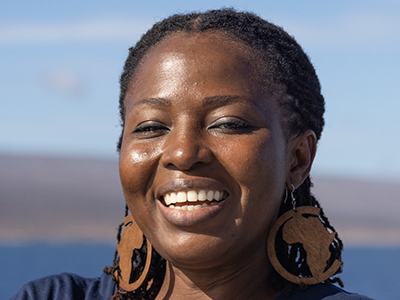
Citation
It’s an honor to recognize Dr. Edem Mahu, faculty member in the Department of Marine and Fisheries Sciences at the University of Ghana (UG), for the 2022 Africa Award for Research Excellence in Ocean Sciences. I thank Kwasi Appeaning-Addo (UG), Sophie Seeyave (Partnership for Observation of the Global Ocean, POGO), and the late Kenneth Coale (Moss Landing Marine Laboratories, MLML) for outstanding letters in support of Edem’s nomination.Edem’s research addresses marine issues of great practical importance. As a UG Ph.D. student, while visiting MLML, she analyzed sediment cores from coastal environments in Ghana for sediment rates, trace metal distributions and environmental toxicity. Edem and her students have published several lab-based lead-author papers in international peer-reviewed journals. However, until recently, Edem did not have the kind of lab that researchers in higher-resourced nations expect. She instead relied upon facilities outside Ghana. Recently, Edem has acquired a well-equipped laboratory at UG. Her group’s research productivity will no doubt accelerate as a result.
Edem has taught several different UG courses, supervised or co-supervised eight graduate students, and supervised 20 undergraduate researchers. To support her team’s research, Edem has received more than $1,000,000 of funding from several entities outside of Africa. Edem’s funded projects range over shellfisheries, plastic waste, microplastics, mangroves, toxic metals, ocean acidification and citizen science monitoring of litter.
Edem has worked tirelessly to bring African institutions into international research networks. For example, she is on the POGO Board of Trustees. I have been collaborating with Edem since 2015 on the Coastal Ocean Environment Summer School in Nigeria and Ghana (COESSING; https://coessing.org) and, more recently, on other United Nations Decade of Ocean Science activities.
As stated in support letters, Edem is a perfect example of a scientist with training abroad who chooses to use her training and networking skills to develop science in her home country. She sets a shining example to younger African scientists, as evidenced by the flood of congratulatory messages for Edem in our COESSING network after this award was announced. Many oceanographers outside of Africa have turned to Edem for collaboration in global research and capacity development projects. Indeed, so many demands are made of Edem’s time that she has recently learned to say no, and I can’t blame her. Edem’s plate will continue to grow as she realizes her full potential as a leader in African ocean sciences research, education and capacity development.
— Brian Arbic
University of Michigan
Ann Arbor, Michigan
Response
It is deeply gratifying to receive this recognition of a lifetime from AGU. Creating an award to honor the efforts of ocean scientists from Africa is a true reflection of AGU’S core values of diversity, research excellence and equity.
I am highly pleased to be the recipient of the 2022 Africa Award for Research Excellence in Ocean Sciences. Indeed, with this award, a new chapter has been opened with an all-renewed passion to drive research excellence in ocean sciences in Africa. The award has become a symbol of hope to several young ocean scientists on our continent that their little efforts can make a big difference in our community.
I must confess that the decision to pursue a career in ocean sciences in West Africa was intrepid. The most rewarding aspect of this journey has been my ability to serve our global community, mentor several young scientists, and facilitate the development of ocean science capacity in Africa, while at the same time striving to develop my research as a young woman scientist. Creating opportunities for young scientists has been my utmost goal. It is important to therefore highlight from Professor Brian Arbic’s citation that truly, I started my career in marine biogeochemistry without a research laboratory. Today, with generous support from organizations such as The Royal Society, Partnership for Observation of the Global Ocean, the United Nations Educational, Scientific and Cultural Organization’s Organization for Women in Science for the Developing World, the National Geographic Society, the African Academy of Sciences, International Foundation for Science etc., I have a laboratory that accommodates the research of several students in this field.
I am very grateful to my nominators, Professors Brian Arbic, Kenneth Coale and Kwasi Appeaning Addo and Dr. Sophie Seeyave, for writing the winning application. A special tribute to Professor Kenneth Coale, my first mentor, who, sadly, departed this life just a few weeks before this award was announced. I dedicate this award to you, Kenneth, for the difference you have made in my entire career and life. I know you are smiling wherever you are now to see your wife, Susan, accompany me to this ceremony on your behalf.
I am sincerely grateful to the University of Ghana for offering me the platform to serve the world.
Finally, I wish to appreciate my husband, who should have been here with me today to celebrate this special moment but, as has always been, is currently back in Ghana caring for our sons, Kwesi, Kwabena and Kwaku, while I am away. To my family, I say Akpe!
Thank you.
Field Photos

Citation
Noemi is an exceptionally talented early-career researcher whose research on computational hydrology has provided outstanding contributions to solving water and food security challenges. Noemi develops scalable approaches for hydrological prediction by advancing realism in hyperresolution (tens of meters) land surface models through big geospatial data, satellite land data assimilation, machine learning and high-performance computing, including the representation of human water management such as irrigation and groundwater pumping. These cutting-edge computational approaches enable monitoring and understanding of complex hydrological processes at unprecedented spatial scales and over continental domains that otherwise would be infeasible. Noemi’s work bridges a significant research gap and forms the basis for solving societal problems around water and food security, targeting the spatial scales at which impacts occur and decision-making is implemented, through improved monitoring of crop water demands, hydrologic extremes and other natural hazards.She developed an assimilation framework (Vergopolan et al., 2020, Remote Sensing of Environment) to represent soil moisture variability at local scale which outperformed state-of-the-art satellite estimates and applied this approach to crop yield prediction (Vergopolan et al., 2021, Hydrology and Earth System Sciences), showing how localized estimates of food security risks are feasible across national domains. These tools are now being used for solutions on the ground, for example, forming the basis of operational flood early warning in southern Africa and quantifying maize yield gaps at field scale in Malawi to provide evidence to national food security policy. She has also pioneered the development of open-source, continental domain, hyperresolution data sets (Vergopolan et al., 2021, Scientific Data) that have potential for applications in water resources, agriculture, ecology and biogeochemistry and has enabled for the first time understanding of the scaling behavior of soil moisture at continental scales (Vergopolan et al., 2022, Geophysical Research Letters). Her current work on improving operational weather and subseasonal climate forecast systems as part of a NOAA fellowship has potential to provide early warning of hydrometeorological risks, especially for the most vulnerable of society.
Noemi’s research profile is outstanding for a researcher only 1 year since her Ph.D., with much of this a result of multidisciplinary collaborative work, which is critical to address complex societal problems around water, food and climate. As a young, female researcher from Brazil who has made great strides in the early part of her career, she is a role model for other young and talented Latin researchers and has done much to promote Earth and environmental science within and by this community.
— Justin Sheffield
University of Southampton
Southampton, United Kingdom
Response
I am thrilled and honored to receive the AGU Science for Solutions Award. I am immensely thankful to Justin Sheffield for nominating me; his pioneer research on monitoring droughts and changes in terrestrial water through decision-supporting tools inspired me and shaped the scientist I am today. I also want to thank Elie Bou-Zeid, Marc Bierkens and Jay Famiglietti for their tremendous support in my nomination and throughout my scientific career.
As hydrologic and climate predictions depict a future in which floods and droughts are the new normal, climate change poses an imminent threat to water and food security worldwide. To adapt and mitigate climate change impacts on freshwater systems, locally relevant hydrologic information is critical to support governance and water resources decision-makers in designing local interventions and implementing policies. We bridged this data gap by advancing realism in hyperresolution land surface models through big geospatial data, satellite land data assimilation, machine learning and high-performance computing. These novel approaches enabled hydrologic predictions at unprecedented scales and now are forming the basis for flood early warning in southern Africa and providing evidence to national food security policy in Zambia and Malawi. As a scientist, very little is as rewarding as seeing the impacts of our efforts on improving livelihoods.
As Eric Wood would say, pushing the scientific barriers requires courage. Courage to be creative, courage to be persistent, and courage to think in ways others aren't. As scientists, it is our duty to embrace challenges in water and food security with courage, as the future of the next generations depends on the scientific advances we make today. For a positive impact on society, it has been my mission to advance hydrological monitoring and predictions targeting the spatial scales that can support solutions on the ground.
I am grateful to my Ph.D. advisers, Eric F. Wood and Justin Sheffield — their research vision and commitment to scientific excellence have always inspired me. I am thankful to Nathaniel Chaney, Niko Wanders, Elena Shevliakova and Hylke Beck; their mentorship and encouragement nurtured the researcher I am today. I am deeply grateful to all who supported me along the way and to AGU for honoring me with the 2022 Science for Solutions Award.
— Noemi Vergopolan
Princeton University
Princeton, New Jersey
NOAA Geophysical Fluid Dynamics Laboratory
Princeton, New Jersey
Field Photos
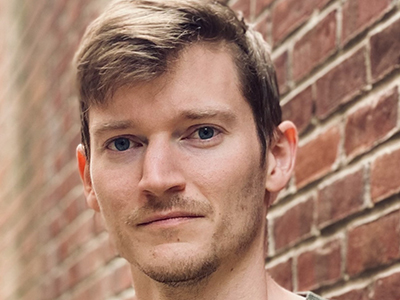
Citation
In a remote part of Nevada called Rhyolite Ridge, there is a hill with enough lithium to power batteries for about 400,000 electric cars a year for 25 years. At a moment when mitigating the effects of climate change becomes more urgent by the day, this was an extraordinary find. But the geologic peculiarities of that ridge also created the conditions for something else: the singular location of a homely little plant called Tiehm’s buckwheat.Greg Barber pitched the editors at WIRED a mystery story: a field of buckwheat that had been holding up the construction of a mine had been destroyed. Who did it, and why? It wasn’t a hard sell. But over several trips to Nevada, the story became more complex. In “The Lithium Mine Versus the Wildflower,” Greg explores a familiar story with a twist. We have come to expect environmentalists and corporations to fight over the environmental costs of economic activity, but in this situation the economic benefits eventually would accrue to the whole planet. Does that change the risk-reward calculation?
Greg is a rare combination. A soft-spoken and unassuming interlocutor, he nonetheless contains a lock-jaw tenacity. He will not be satisfied with a fact until he has examined it in every light. But nor is he satisfied to merely arrange a logical sequence of indisputable facts. He has a supple, inquisitive mind, and with this story, he wasn’t just interested in the debate over whether a plant with no economic value and the Endangered Species Act should hold up a lithium mine. Rather, the story became an interrogation of the nature of nature and what we, as humans, owe to species that have evolved their peculiar forms and their ecosystems over millennia. His persistence and eloquent ability to turn chemistry and botany into poetry challenged my own beliefs and assumptions. And for that, I am ever grateful.
— Vera Titunik
Formerly at WIRED
Now at The New York Times
New York, New York
Field Photos
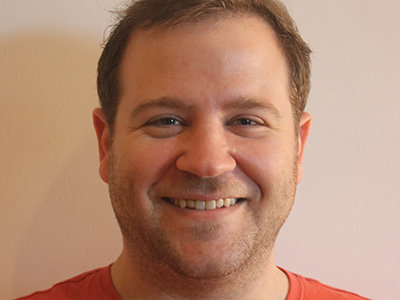
Citation
Dr. Robin George Andrews is an exemplary journalist with the rare ability to convey complicated scientific concepts in elegant, accessible prose for a general readership. His award-winning National Geographic article on recent research around the fatal 1959 Dyatlov Pass expedition provided our readers with a thoughtful look at the hard science that transcended the myriad of conspiracy theories around the notorious event.Robin holds a doctorate in experimental volcanology and has drawn on his background for articles published in the New York Times, Scientific American, the Atlantic, Nature, Science, Discover, CNN, WIRED, and other important mass-market outlets with international reach. Robin also provides important outreach on scientific topics for television news, as well as public lectures. In addition to the 2022 AGU David Perlman Award, he has been recognized as the European Geosciences Union’s 2022 Angela Croome Award winner for continued, excellent and successful reporting of Earth, space and planetary science topics.
Robin’s work includes notable essays in the 2021 and 2022 editions of the Best American Science and Nature Writing and multiple honorable mentions and top picks on Science Shortform’s best science journalism roundups. His 2021 book Super Volcanoes: What They Reveal about Earth and the Worlds Beyond is (at the time of writing) the #2 book on geophysics on Amazon and a testament to Robin’s ability to engage general audiences with scientific topics. His forthcoming book How to Kill an Asteroid is a timely, nonsensational look at the threats that we face beyond our planet. Journalists like Robin who have the knowledge, enthusiasm and skill to create lively accounts firmly grounded in science will be our best front line in a world of increasing scientific mis- and disinformation.
— Kristin Romey
National Geographic
Washington, D.C.
Response
Writers get their inspiration from a variety of sources, but I tend to find mine in the modern mythology that is pop culture — from The Legend of Zelda to The Expanse. But above all else, I look to Doctor Who, especially when it’s at its magical realism best. Time travel is a powerful tool, one allowing anyone to tell beguiling stories about the incongruous cosmos we inhabit.
Science journalism isn’t that different from time travel. Anyone with this occupation gets to write about people and places that exist not only in the present but in the most distant past and in any of the many futures that may come to pass. We get to tell tales of dramatic things that, despite being grounded in reality, can be more fantastical than anything we could find in fiction.
The Eleventh Doctor once said this: “We’re all stories in the end. Just make it a good one, eh? Because it was, you know, it was the best: a daft old man, who stole a magic box and ran away.” Science journalists, especially those on the wonder beat — a beat that I firmly enjoy inhabiting — don’t have any magic boxes that can travel through space or time. But we do have our words, rearranged in a way that, if we’re lucky, lights up our readers’ minds and brings a smile to their face by transporting them somewhere, well, magical.
The world is frequently terrifying; things often seem precarious and beyond our control. There are an army of talented and tireless reporters, scattered across the planet, covering stories of war, inequality, prejudice, climate change and oppression every day of every week, sometimes at great personal risk. We’re all fortunate to have them. But we also need wonder in our lives.
This award, which I’m deeply honored and humbled to have received, may be for a story suffused with macabre elements. But solving such a long-standing mystery was only possible thanks to the unyielding curiosity of the scientific sleuths that took the case on —well that and the movie Frozen. All of us — scientists, journalists, everyone — want to know how the world works, how the universe operates. It’s a strange place to find ourselves. It's wondrous. That I get to play the role of tour guide, taking readers on remarkable journeys through it, is one of the greatest joys of my life.
— Robin George Andrew
Freelance Science Journalist
Field Photos
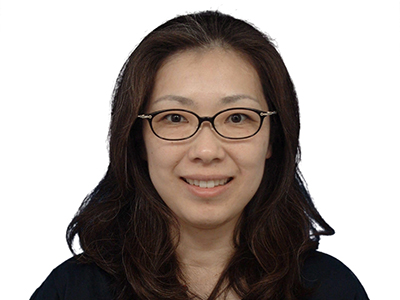
Citation
Hiroko Kitajima is at the vanguard of international research efforts to advance our understanding of plate boundary faults via scientific drilling. She has carried out foundational research and has excelled as a team leader during technically challenging expeditions to the Cascadia, Nankai, and Hikurangi subduction zones, as well as onshore drilling into the San Andreas and Alpine plate boundary faults. The Asahiko Taira Prize sets an extraordinarily high bar for a recipient: they must be early to mid-career yet have demonstrated “outstanding, transdisciplinary research accomplishment in ocean drilling.” Hiroko’s sustained, masterful and innovative research that brings together fault mechanics, physical properties and structural geology to investigate the planet’s most active and hazardous fault zones easily measures up. Hiroko has emerged as a leader in the scientific drilling research community more broadly through her careful and creative work, her command and breadth of knowledge and her talent for organizing team efforts.The balance between frictional locking and slip in these largest of all faults is governed by the tectonic stress conditions, material properties and pressure and flow of pore fluids. All of these are notoriously hard to measure, and there are remarkably few places where our models for fault mechanics have been rigorously evaluated. Hiroko has developed and tested groundbreaking methods — rooted in experimental rock mechanics, geotechnical engineering, sedimentary geology and borehole geophysics — to determine in situ stresses and pore fluid pressure. Her approach has changed the way the community thinks about this problem and has provided among the most exacting of precious few existing constraints on the stresses along active subduction faults, illuminating in particular the low-stress and high-pore-pressure conditions that appear to promote slow earthquakes.
In addition to her scientific achievements, Hiroko has been a team leader in the shipboard laboratories on both the JOIDES Resolution and Chikyu, including a critical role as co-chief scientist for the technically complex ultradeep International Ocean Discovery Program (IODP) drilling Expedition 358 at the Nankai Trough. She was perfectly suited to be the bridge between the scientists and the engineers in this complex effort. Her body of work demonstrates that Hiroko Kitajima is a leader in brittle fault mechanics research today, especially in work that leverages the power of samples and data obtained by drilling, both in IODP and on land. I am confident that scientific fault zone drilling will be a better and more fruitful effort through her leadership for decades to come.
— Harold Tobin
University of Washington
Seattle, Washington
Response
I am greatly honored to receive the Asahiko Taira International Scientific Ocean Drilling Research Prize. About 15 years ago, I met Dr. Taira for the first time when I participated in a public ship tour of Chikyu. At that time, I never imagined my career in ocean drilling research or being a scientist. I would like to give a special thanks to Harold Tobin for his kind citation as well as his mentorship for many years.
My endeavor to understand the mechanics of earthquakes, particularly in subduction zones, initiated when I came to Texas A&M University for my graduate study, which was encouraged by my undergraduate adviser, Toshi Shimamoto. Conducting experimental rock deformation research using ocean drilling cores was one of the reasons why I chose Texas A&M (TAMU). During my Ph.D., I had an opportunity to sail for Expedition 311: Cascadia Margin Gas Hydrates and conduct research on the samples from the Nankai Trough, thanks to the generous support from my advisers, Fred and Judi Chester, and my committee member, Giovanna Biscontin, who made my foundation about soil mechanics. During my postdoc time, I was able to expand my research by integrating laboratory deformation experiments on the core samples with geophysical observation to quantitatively estimate the stress state and pore fluid pressure along the plate fault boundary at the Nankai Trough. I enjoyed and am still enjoying discussions with my postdoc adviser, Demian Saffer, on soil and rock deformation.
My career in ocean drilling research was greatly established through my participation in a decade-long IODP project, the Nankai Trough Seismogenic Zone Experiment (NanTroSEIZE), as a shore-based scientist at the beginning, as a shipboard scientist in Expeditions 338 and 348 during Stage 2, and in a leadership role for the most recent expedition, Expedition 358. I enjoyed meeting and working with many researchers and learned a lot about leadership and management of such a large and challenging drilling project. I greatly appreciate the NanTroSEIZE project coordination team members, Harold, Demian, Masa Kinoshita, Greg Moore, Gaku Kimura, and Mike Underwood, for their encouragement and generous support to early-career scientists like me.
Lastly, I am grateful for the support from the ship operational offices for the JOIDES Resolution at IODP-TAMU and for Chikyu at the Japan Agency for Marine-Earth Science and Technology (JAMSTEC). Without their support, none of the scientific ocean drilling research would have been possible. I also thank my friends, colleagues and family who have been supporting my journey.
— Hiroko Kitajima, Texas A&M University
Field Photos
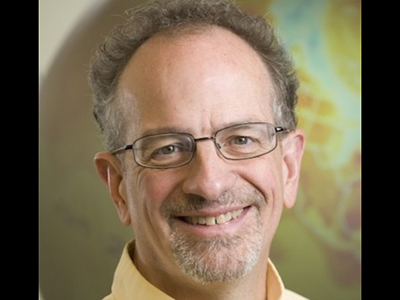
Citation
Climate scientist and Colorado State University professor of atmospheric science Scott Denning is a passionate and effective communicator of the seriousness and solvability of climate change to any and all audiences. From school children to TV meteorologists to contrarians, Dr. Denning leaves no stone unturned in his quest to help people understand the threats and opportunities posed by human-induced climate disruption.Armed with the wisdom of the experts and the energy of the innocent, Dr. Denning takes on all comers and goes to those who would be reluctant to approach him. He has even attended conferences put on by climate contrarians and approached this challenge with humility and compassion. He brings his passion and sense of humor to the challenge of climate change communication to the young and young at heart. From his dancing like a molecule to making sound effects of their vibrations, it’s difficult to imagine anyone bringing more aspects of himself to his communications efforts, using his body, his voice, his brain and, perhaps most of all, his heart, to his unusual methods of engaging his audiences.
He devised an ingenious framework that presents climate change as simple, serious and solvable. Starting with why it is simple, he reviews the basics of Earth’s heat budget. Using dancing molecules and their vibrations, he explains why carbon dioxide and other greenhouse gas molecules trap heat. Saying it’s not rocket science but steam engine science, he shows that we have understood the greenhouse effect since the 1800s because it’s really just common sense. Explaining why it is serious, he talks about the impacts of climate change on places and things his audience cares about. As for solvable, he talks about the abundance of clean energy resources and their rapidly falling prices. He shows how quickly society has made big changes in the past and how each generation has taken on enormous challenges and thereby changed the future.
Scott Denning’s tireless and creative approach to communicating about climate change makes him a most worthy recipient of the 2022 AGU Climate Communication Prize.
— Susan Joy Hassol
Climate Communication
Asheville, North Carolina
